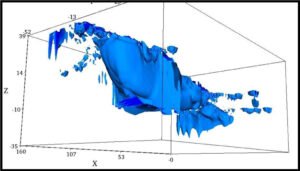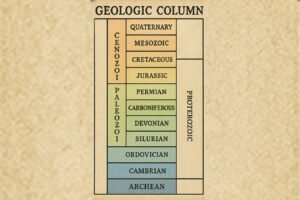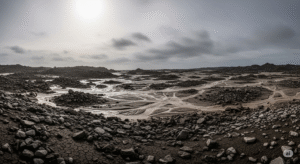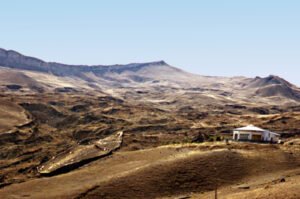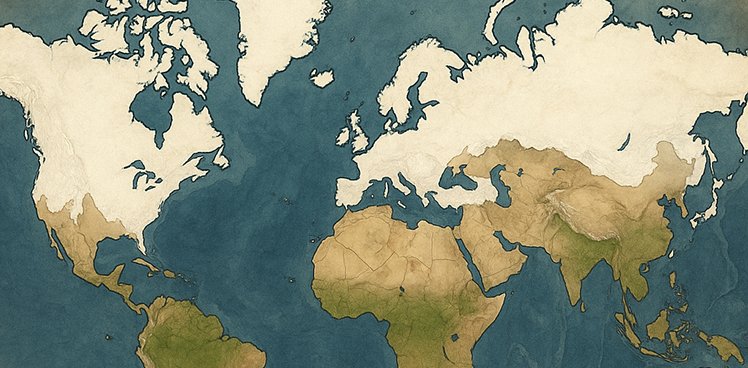The Animals on the Ark vs. the Animals We have Today
Everything God does has Real Purpose
During the flood, as we explained earlier, the heavier elements were deposited in the deepest layers. The decay of these isotopes began to produce heat. Peter explained how God had destroyed the “old world” (pre-flood world) with water, but the world that is “now” (the post-flood) is to be destroyed by fire:
2PE 3:6 Whereby the world that then was, being overflowed with water, perished: 7 But the heavens and the earth, which are now, by the same word are kept in store, reserved unto fire against the day of judgment and perdition of ungodly men.
His “arsenal” was prepared during the flood for the final destruction of the present-day face of the earth. But before that day would arrive, this same arsenal played a great role in accomplishing another work He ordained- a work that had its effect during the time of Peleg.
Man had wanted to united into “one people” at Babel, contrary to God’s command. At their refusal to obey, He confounded their languages and they were forced to separate and spread out upon the face of the earth. Once they had done this, to insure their separation, God melted enough of the glacial ice to raise the sea-level enough to isolate the continents.
Sea-Level was Lower after the Flood than We are Told
Present-day scientists claim sea-level was between 330 and 460 feet lower at the height of the “Ice Age”; however, other evidences indicate that it was much lower than that. One of the best evidences which show that sea-level was MUCH lower is found in some coral reefs.
The Evidence from the Coral Reefs
A coral reef is an underwater ridge or mound consisting of the skeletons of corals, limestone, and other organisms such as coralline algae binding the various components together. They are found in tropical seas and form ONLY in shallow water because sunlight penetration is necessary for algae photosynthesis which supplies the living coral with nutrients and oxygen. Because light can only penetrate water to a certain depth, corals of even the deeper water type are rarely found in depths greater than 150 to 200 feet.
They also thrive best in warmer temperatures ranging from 77˚F to 86˚F with some able to grow in as little as 67˚F. There are 4 basic types of coral reefs- “fringing reefs” which border a shore; “barrier reefs” which are at some distance offshore, parallel to the coastline; “atolls” which are circular enclosing a lagoon of water; and “table reefs” which are roughly circular, lie just below sea-level, and are solid across.
Interestingly, there is a large number of reefs, many of them “atolls”, that are many, MANY feet below sea-level, some over 1,000 feet. “Atolls” are circular reefs which form around underwater volcanos, attracted to the ever so slight warmth generated by the volcano. Yet, even with this added warmth, coral reefs still couldn’t form without the sunlight necessary for the algae photosynthesis which is so vital to the corals existence. Therefore, we know of a certainty these atolls did not form in this deep, deep water.
The answer is simple- the abundance of these coral reefs found at depths far below that at which they are able to live, is absolute evidence that the sea-level has risen a great deal since their formation. When it was much shallower, these reefs began to form. When the waters of the melted glaciers raised the sea-level, these reefs which were once perhaps 100 feet deep were now 500, or 800 or even 1,000 feet deep.
While today’s scientists will readily concede that the melting of the glaciers raised the sea-level anywhere from 330 to 460 feet, the evidence of the coral indicates an even greater rise.
The Americas- Completely Isolated
Evolutionary scientists all agree that at one time the sea-level was low enough that the Bering Strait was dry land, allowing man to travel to North America. No one knows how many people originally arrived here prior to the “division” of the earth, or the isolation of the continents. However, there is evidence that the earliest inhabitants possessed a much higher level of technological knowledge than is commonly known- a knowledge which didn’t increase as man “evolved” (according to the theory of evolution). This phenomenon is exactly what we have seen in the earliest civilizations of Mesopotamia, Egypt and the Indus Valley, although these were civilizations of a much larger scale.
Australia- Completely Isolated
Scientists and scholars admit that the sea between Asia and Australia was once much lower, forming vast land masses.
“Until 12,000 years ago, when the melting of the Ice Age ice caps raised the level of the world’s oceans several hundred feet, Southeast Asia and Indonesia formed a single huge subcontinent known as the Sundra Shelf.” (Mysteries of the Past”, Lionel Casson, Claiborne, Fagan and Karp, American Heritage Pub. Co., NY, 1977. p. 223)
The Sahul Shelf, to the east and south, included Tasmania, New Guinea, the Melanesian Islands, and Australia.
“The significance of the Sundra and Sahul shelves is clear. In no part of the world other than southeast Asia, Indonesia, and Australia are the seas so shallow that vast interconnecting land masses could have been created when the icecaps of the polar regions trapped enough water to lower the sea levels in many parts of the world by forty fathoms below their present shorelines. The Sundra and Sahul shelves are the only real `lost continents’.” (Mysteries of the Past”, Lionel Casson, Claiborne, Fagan and Karp, American Heritage Pub. Co., NY, 1977. p. 45-6.)
But, they also claim that theses 2 “shelves” were separated by about 60 to 75 miles of water. As we have seen by the evidence of the coral, the sea-level after the flood was much lower than today’s scientists will admit- in fact, it was low enough to allow man to travel to the Australian continent on dry land.
And the continent which has remained the most isolated and untouched by outside influences for the longest period of time is Australia. When the British began colonizing New South Wales in 1788, Australia still remained uninfluenced by the outside world. The population of Australia until well into the 3rd millennium after the flood consisted of what we called the Aborigines.
If indeed these people were the descendants of those who first arrived after Babel, and they had no contact with the outside world for all that time, it should be interesting to learn about these people. If, as is taught today, man and animal “evolved” from lower life forms, we should find no similarities among those that have evolved in isolation with those who evolved in other areas. If, as WE believe, they all originated with the people and animals brought through the flood on the ark, we should find evidence of that.
First, the Animals
The Biblical account tells us that all the animals on the planet today are the descendants of those that were on the ark. The common concept today is that 2 of each unclean animal and 7 pairs of every unclean “species” were on the ark- but that is not the case. It would have been impossible for the ark to contain that many animals.
Substitute the word "kind" with "genus".
Take, for example, the buffalo. It is a mammal of the family Bovidae, the order Artiodactyla. Artiodactyla, an order of mammals, have certain unique features, such as an even number of hoofed toes on each hind foot. Included in this “order” are cattle, deer and pigs. Some chew the cud, some don’t. Some have antlers, some don’t. Of course, these subdivisions and classifications of animals are man-made based on our present knowledge.
But there is evidence in Australia that many different species may very likely be the descendants of only TWO common ancestors that were on the ark, which will explain why there didn’t have to be nearly as many animals with Noah as is commonly thought.
The Marsupials
Everyone is familiar with the very unique animals found in Australia that are found nowhere else on earth. Most of these are what we call “marsupials”, which are characterized by their premature birth and continued development while attached to the nipples on the lower belly of its mother. Most of these have the familiar “pouch”, or “marsupium”, which is how they received their name.
These include kangaroos, wallabies, wombats, koalas and a large number of rodent-like forms. In Australia and the islands surrounding them (in the areas once above water prior to the rise in sea-level) there are about 170 species of marsupials.
The only other place on earth where marsupials are found are in South, Central and North America. Consisting of 2 families of about 65 to 70 species, all but one are found from Mexico to Argentina. Above Mexico to southern Canada is found only “Didelphis Marsupialis”, our familiar “possum”. Yet fossil remains of marsupials have been found all over the world- Europe, Africa, Asia, etc.
We don’t know what the original animals were on the ark, but we DO know that they contained the gene-pool of every animal that would later exist on the earth. The few animals that made it to Australia before it was isolated included marsupials, as did those that made it to the Americas.
The only other animals in Australia when the Europeans arrived were the dingo (wild dog), rat and bat.
What does all of this tell us? It tells us that very few animals made the long trip from Turkey to Australia before the sea-level rose and isolated the continent. It also tells us that all the varied species of marsupials found there came from a very few common ancestors. It would be ludicrous to think that all those hundreds of various marsupial species made it to Australia while but a couple of other animals did.
Classification of Animals Based on “Evolution”
The term “species”, “genus”, “families”, and etc. are terms coined by man to classify animals under a system which is influenced by the theory of evolution. But, this entire system of animal classification was designed by “men”, not God, and is therefore not reliable.
How does God classify animals? In the Biblical account, we read:
GEN 6:19 And of every living thing of all flesh, two of every sort shalt thou bring into the ark, to keep them alive with thee; they shall be male and female. 20 Of fowls after their kind, and of cattle (behemah) after their kind, of every creeping thing of the earth after his kind, two of every sort shall come unto thee, to keep them alive.
This passage shows us that God indicated only 3 main divisions of “every living thing of all flesh” (animals) that were to come on the ark- fowls (birds), “behemah” (NOT strictly cattle, but more accurately “beasts”) and the “creeping thing”.
All God tells us is that His 3 divisions of “living things of all flesh” are fowls, beasts and creeping animals. Within each category, He told Noah to take 2 of each “after his kind”. (This is excepting the 7 pairs of each clean animal).That’s it. That’s all we are told.
We simply don’t know what the original “kind” were, no matter what geneticists and other scientists today may tell us. I suspect that we would all be VERY surprised to learn what the original animals were on the ark.
Our Knowledge of Genetics Severely Limited
Right after the flood, in order for mankind to grow in population, people had no choice but to marry relatives. That’s all there were to choose from. Yet today, we cringe in horror at the thought of blood related people getting married to each other. Why?
Today, with our new knowledge (which is STILL severely limited) we know that there is “genetic” material contributed by each parent which gives offspring their characteristics. At this late date in the “life” of mankind, as well as the animal kingdom, it appears that we have reached the “dead-end” of the gene-pool. In other words, the possible genetic combinations that can find their expression in what we term a “species” have all but been exhausted. But there is more to consider before we think we know it all.
If God is Who we believe He is, then we KNOW He was certainly able to ensure that Noah’s family possessed a gene-pool without flaws, or at least relatively flawless, or else the human race would not have survived. As they reproduced, this gene-pool thinned out, as we today have every color of skin, eyes, hair, every shape body from tall to short,- in short, every characteristic of the human race today had its beginnings in the genes of Noah’s family.
Defective Genes Arose Over Time
Somehow, sometime, defective or mutated genes arose. Present day science has shown that genes mutate due to environmental factors, radiation, certain foods, and other reasons we don’t know about.
Genetics is a very complicated subject, but to make the point, we need to understand only that it’s a well-known fact that if two people marry, one with a defective gene causing a certain defect or disease, and one with a non-defective gene, their off-spring have a chance of NOT inheriting the defect (this is a broad statement, intended only to illustrate a point, which does not take into consideration “recessive” and “dominant” genes, as well as other more complicated factors.). But, the defective gene may have been passed on to the child who, although free of the defect, becomes a “carrier” of that gene and capable of passing it on to its offspring.
Now, if two closely related people marry who are from a family with a defective gene, and both are carriers, the chances are that their off-spring WILL have the defect. Thus, “in-breeding”, or marrying within one’s own family, significantly increases the chances of producing children with genetic defects and illnesses. Albinism, insanity, deaf-mutism and cleft palate were commonly found in families who had inbred for long periods of time. Finally, sterility and infant mortality is much higher in these unions than others.
So why didn’t all this happen to Noah’s family? Why didn’t they all have defects from in-breeding? The only answer can be that they started out with no defective genes. In order for mankind to effectively repopulate the earth, God made sure that they could produce healthy off-spring by providing them with a “clean slate” to start out with.
But after an unknown period of time, if people kept marrying who were closely related, these defective genes would start crippling the population. We know that God gave specific instructions to the people through Moses forbidding “kinship” marriages. But the evidence indicates that He also made it known to the people prior to the dispersion from Babel that it was important for man to marry as far from his own blood-line as possible. How do we know? Because the earliest civilizations, those soon after Babel, all had strict laws about incest and marrying within your own family. More on that later.
But what does this have to do with animals? It tells us that God has set limits or bounds to insure the diversity of His creation and also to maintain the purity of that which He created. It also tells us that He made certain “genetic exceptions and provisions” at the time of the flood that no longer are valid today. He obviously took great care to insure that mankind, in its rebirth after the flood, would have the best genetic material with which to begin.
Man, alone, was created in His image. From the beginning, with Noah’s family, the “order” or “family” of man would not branch out into new species. Although mankind would exhibit various shades of skin color, hair color and texture, eye color, and size, he would always remain as God created him. And though closely-related humans risk producing defective offspring, God made special provisions to accommodate the situation after the flood.
What Animals Were On the Ark?
But the animals are different and varied in many, many ways. As the diversity of man found it’s expression down through the ages in various types of coloring, etc., in animals, there is evidence that many “species” (as we call them) were the expression of the genetic union of other animals NOT of the same species.
Of the fossils of pre-flood animals that have been found, many are of the same “families” we have today, but of different “species”- these are termed “extinct”. Many are much, much larger than those we have today while some are smaller.
We know that some animals possess abilities to adapt to various climates and terrain and it appears that as the animal kingdom began to make its way into all the earth after the flood, certain “species” arose (from the union of the original animals on the ark) that were specially adapted to each region they entered. This meant that there wouldn’t necessarily be the same “species” all over the world, even though they descended from the same original parents.
Similarities in Placental and Marsupial Mammals
There is an enormous amount of evidence which indicates that the present-day animals are really the results of the early pairing of animals that we may not consider to be of the same family. The marsupials of Australia are a good example of this.
This fact has not gone unnoticed by the scientific community:
“Marsupials are of interest to zoologists for several reasons:... their similarity in many respects to placental mammals,...”(Encyclopaedia Britannica, vol. 11, p. 537, 1985.)
Some look exactly like placental shrews, moles, mice, squirrels, and the “thylacine” is termed the Australian “wolf”. Yet, they have a completely different reproductive system, along with other traits which make them unique. Is it possible that placental and marsupial mammals shared a common ancestor in some cases which accounts for their similarities?
It appears that as the animal world became more diverse, with more and more “species” appearing, they reached the limits God had set to insure their diversity and maintain their purity. With no more possibilities of successful combinations between animals that had differences but were of the same “kind”, variations ceased to be produced (except for things like color, size, etc.).
God Controlled Breeding in the Animal Kingdom
“Cellular incompatibilities” prevented animals from successfully breeding with other similar animals, some which may seem almost identical to them. Some animals that seem so very similar, such as “mice and rats”, have never even produced a sterile hybrid.
The mystery of “instinct” took over and animals automatically knew who to mate with. There are a few animals which have been artificially cross-bred by man, such as a lion and a tiger (a tigron) and a mare and a he-ass (the mule), but the result has been in most cases that the off-spring (called “hybrids”) were sterile. In short, the animal kingdom appears to have, to a large extent, reached it’s genetic combination limit
New Species from Old Species?
The presence of the large and varied marsupials in the isolated Australian continent is strong evidence of the unfolding of the gene-pool of a small number of original animals which first came there after the flood. Less this seem too farfetched, consider Dr. Six’s primroses.
The story goes back to the discovery of America which is the only place the primrose was found at that time. Later explorers took some home with them and in the 1880's, Dr. Six planted some in his ornamental flowerbed. Soon, they outgrew the flowerbed and spread to his potato patch. Before long, they were spread over more than an acre of ground.
In 1886, Hugo de Vries, a professor of Botany at Amsterdam was gazing over the field of beautiful flowers with his critical eye. Suddenly, he uttered a cry of astonishment. There in the middle of the primroses were 2 completely new species, differently leafed and with flowers of a different shape. Since they were so closely wedged in among the host of usual varieties they were bound to be direct descendants of those around them.
De Vries took cuttings of these primroses and planted them in the botanical gardens at Amsterdam. Within 13 years, those original plants had produced 7 entirely new species, including some giant forms and some dwarfs. They were not related types or varieties but genuine new species which transmitted their characteristic unmodified.
Welcome to the Ron Wyatt Archives. I'm Mary Nell (Ron's wife) and this site will attempt to fully document Ron Wyatt's work and discoveries. This website will be an ongoing project to document his work on all his various discoveries. Please check back often as new things will be added constantly.
| READ MORE |

